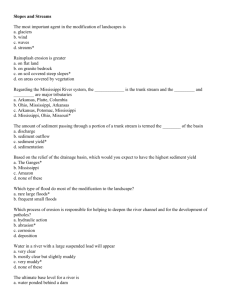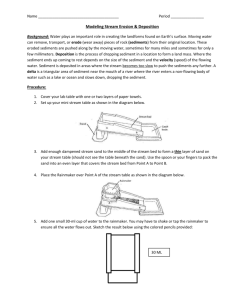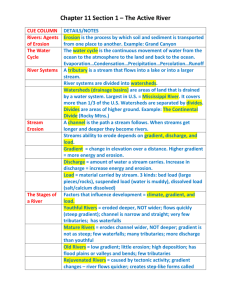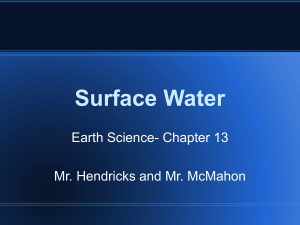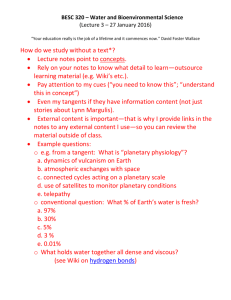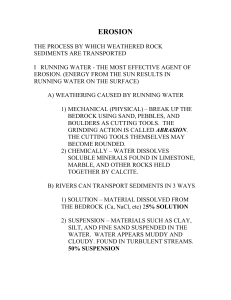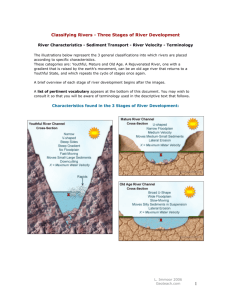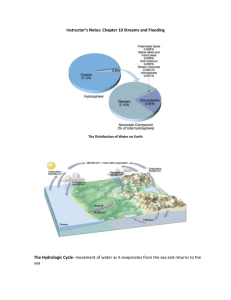Chapter 9
advertisement
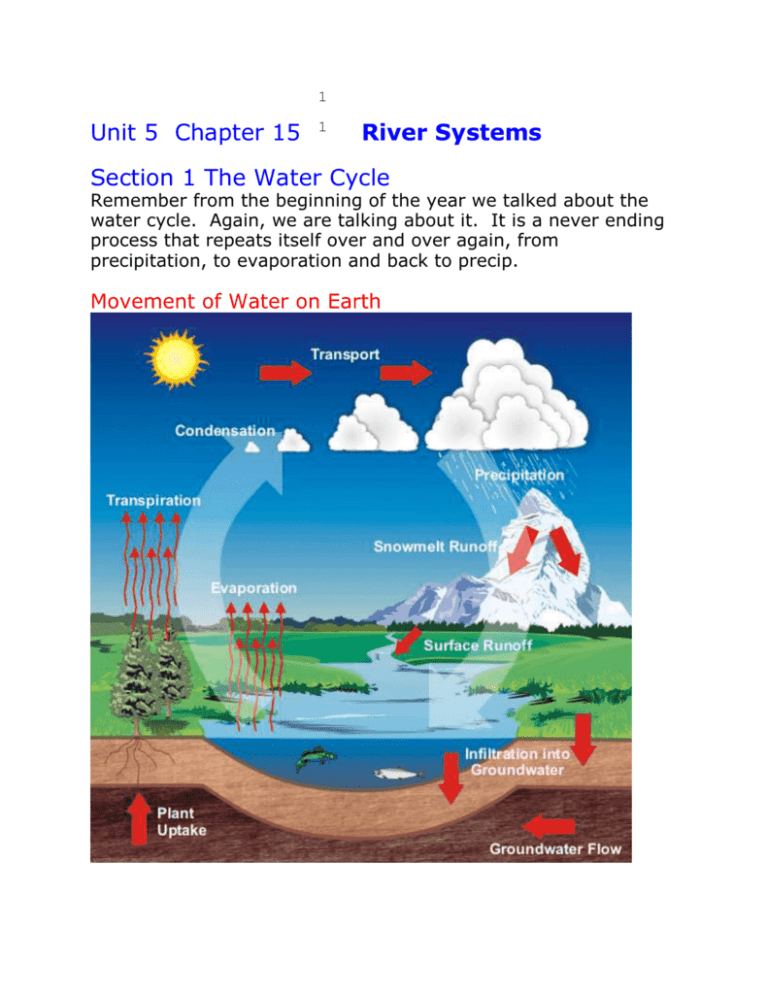
1 Unit 5 Chapter 15 1 River Systems Section 1 The Water Cycle Remember from the beginning of the year we talked about the water cycle. Again, we are talking about it. It is a never ending process that repeats itself over and over again, from precipitation, to evaporation and back to precip. Movement of Water on Earth 2 Where is our water kept ____%of water is in oceans - salt water ____% of water is frozen - glaciers ____%of water is fresh drinking __________________________________ __________________________________ __________________________________ __________________________________ What this really means is that 75% of the fresh water is in the form of Glaciers. _______% of the fresh water that we use for drinking and things is found UNDERGROUND, hence the word GROUND WATER __________________________ Evaporation - water vapor going into the atmosphere - usually by the sun, directly or indirectly - moisture source for local water budget. Transpiration - process by which green plants lose water through their leaves _________________- evaporation & transpiration combined - the way most water enters the air Condensation Condensation - _______________________________________ - must have condensation nuclei (dust) to form clouds Precipitation Precipitation - ________________________________________ Water Budget Water Budget – It is the balance sheet for rain (precipitation) and water usage. Terms: ________- more water than you need - storage is full ______- less water than you need – using water from storage 3 _______ - precipitation less than needed, storage is becoming empty _________- rain greater than needed, adding water back into storage Factors that affect our Water Budget Land use: 1. _____________- removing the trees there is nothing to hold water in ground or prevent run off on surface. 2. Slope of the land – if it is too steep, water will run off unless it is covered by vegetation or plants. 3. Urbanization – ______________________________________ 4. Plant life – when covering the soil, can hold water, removed, allows water to run off. 5. Saltwater encroachment (infusion)- due to over pumping in areas by salt water, it will creep into the fresh water supply. 6. Permafrost – areas where the ground stays frozen up to 100 meters deep. Water Use Over use is a very big problem. When all of the water is removed from underground the ground may become compacted and the ground level drops. This is called subsidence. Foundation failure and structure damage may result. Pollution: Chemicals – brought into the water table by pesticides, fertilizers, and other household items. Sewage – from urbanization Industrial wastes – toxic wastes, Radon – a natural radioactive gas that comes from the decay of uranium. Ground water areas close to this will become contaminated. 4 Conservation of Water Laws have been put into place so that we can keep our water clean and abundant enough to use. There are also ways that we are trying to add to our fresh water supply. Desalination is one such process. Scientists are trying to remove the salt from ocean water and turning it into fresh water. It is too expensive at this time to do as a real solution. Section 2 Stream Erosion River Systems – ________________________________________________________ _________________________________________________________ Parts of a River System ______________________ A stream that runs into another stream _____________________________ It is all of the land that drains into a river including all of the waters from the tributaries. 5 Canyon (gorge, chasm) A river cuts directly down in resistant rock - vertical sides The highland that separates one drainage basin from another is called a divide. ____________________________________________________ East – ____________________________________________ West – __________________________________________ Mississippi River System - ___________________________________ _________________________________________________________ 6 Channel Erosion Head ward erosion ___________________________________________________ _____________________________ – formed by young streams and rivers; they flow fast - Erosion is quick - widens whole valley Gully ________________________________________________ Stream Piracy – When head ward erosion eats through a divide and captures another river. 7 Stream Load How Streams Transport Materials 25% solution - material dissolved into water Ex. Ca, Mg, Fe, Na, CO2, O2 50% suspension- carrying rock materials Ex. clay, silt, fine sand 25% bed load - moving material along the bottom Ex. sand, pebbles, cobbles, boulders Carrying load - total amount of sediment a stream can carry and the size of the particles and on the velocity and volume of water Stream Discharge Discharge – Is the volume of water flowing past a point in a certain period of time. Faster moving water carries more sediment. Velocity – ________________________________________________ Stream Gradient Gradient – the steepness of the slope of the stream. The gradient will Change during the length of the river or stream. It will be great when going down a steep hill or small when approaching sea level. Base Level - lowest level a stream or river gets to - depends on where stream is flowing - Height above sea level or over what types of rocks Sea Level is the ultimate base level because all rivers eventually empty there. Rapids – ___________________________________________________ 8 Water Falls – water falling over a cliff ____________________ – water falling from the falls wears away at the bottom of the cliff leaving an overhang. The overhang eventually falls and the waterfall moves upstream (recedes). 9 Development of River Channels When a stream load, discharge and gradient decreases, they become broader and slower moving, they now are called a river. Meandering Channels Rivers always shift to the outside of a bend - because the outside has the fastest moving water - most erosion. 10 Meanders - _______________________________________ Oxbow Lake - a cut off meander of a river Rivers decrease in speed and deposit sediment All sediment is deposited when a river enters a lake or ocean 11 Braided Streams This occurs when multiple channels are divided and then again rejoined. Section 3 Stream Deposition As a river turns a corner, it will decrease in speed and will deposit its sediment. Swifter moving water will carry the sediment much further. Deltas and Alluvial Fans Delta __________________________________________________ Sediments drop as water slows The river channels are choked by its own sediment ______________ land locked delta - formed as rain water flows down a steep cliff on to flat land 12 Floodplains Flood plains are areas where rivers can over flow. Natural Levees Levee elevated land along rivers - either natural or man made Back swamp low area behind levee, moist full of river deposits Finer Flood Sediments Finer sediments are carried into the flood plains. It is associated with the swampy area that is along the rivers where the sediments are deposited. Human Impacts on Flooding We contribute to flooding by the use of the land. Removing vegetation and trees allows for more free flowing water which creates flooding. Flood Control Prevention 1. ____________________________________________________ 2. Use Dams like the Tennessee River System approx. 50 dams built to help control flooding 3. ____________________________________________________ 4. Create spillways, channels running along the river to trap water and move it away from where it would cause damage. 13 The Life Cycle of Lakes



